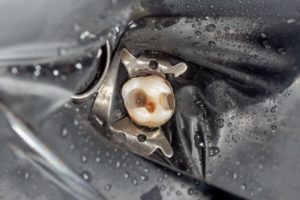 After taking your child to see their pediatric dentist, you learn that they have a severely damaged tooth that needs treatment. While you might think they only need a dental filling or crown, the dentist explains that they need a root canal. Shocked by this revelation, you begin to listen as they rattle off other words that sound unfamiliar such as pulpotomy and pulpectomy. If you’re like most parents, you want to know the difference, which is why you’re encouraged to read on to discover what it is you need to know to help your child better prepare for treatment.
After taking your child to see their pediatric dentist, you learn that they have a severely damaged tooth that needs treatment. While you might think they only need a dental filling or crown, the dentist explains that they need a root canal. Shocked by this revelation, you begin to listen as they rattle off other words that sound unfamiliar such as pulpotomy and pulpectomy. If you’re like most parents, you want to know the difference, which is why you’re encouraged to read on to discover what it is you need to know to help your child better prepare for treatment.
What Causes a Child to Need a Root Canal?
If you think root canals are only for adults, this is unfortunately wrong. Children, too, can succumb to severely damaged and decayed teeth and require this type of invasive procedure.
While it might seem impossible, the most common reasons a child might be recommended for this type of treatment include extreme dental decay that cannot be treated with a dental filling or custom dental crown or severe facial damage that causes harm to the tooth.
How Does a Pulpotomy Differ From a Pulpectomy?
Although pulpotomy and pulpectomy might sound like interchangeable terms, they are not. They are two different types of root canals that children can undergo based on the type of damage that has occurred.
Inside teeth is an area known as the pulp. It is highly sensitive and consists of nerves and blood vessels. When infected or damaged, it can cause much pain for your child and put their existing healthy teeth at risk.
Should your child’s pediatric dentist recommend a pulpotomy, this means that the pulp that exists within the crown of the affected tooth will be removed. However, any pulp that remains in the root canal will stay intact.
If a pulpectomy is recommended, your child’s dentist will remove all of the pulp from the tooth, as this will help to relieve any pain and save the tooth from possible extraction.
No matter which one your child is recommended for, you can trust that their pediatric dentist has their best interest in mind. Even baby teeth that become infected need proper treatment to stay in place until it is time for them to fall out naturally.
Do not be alarmed if your child’s dentist suggests a pulpotomy or pulpectomy. You’ll be glad they are working to save your little one’s smile for a healthier, brighter future.
About the Author
Dr. Veronica Martinez is a trusted pediatric dentist with an office in Scottsdale and Phoenix. Also referred to as “Dr. V,” she is board-certified and committed to improving the smiles of children in the area. Earning her dental degree from Marquette University School of Dentistry, she specialized in pediatric dentistry at Children’s Hospital of Wisconsin. She and her team at Children’s Dental Specialty work hard to keep young smiles thriving year after year, which is why she offers fluoride treatment for those who struggle with cavities. Contact us at our Phoenix or Scottsdale office to find out how we can help.





